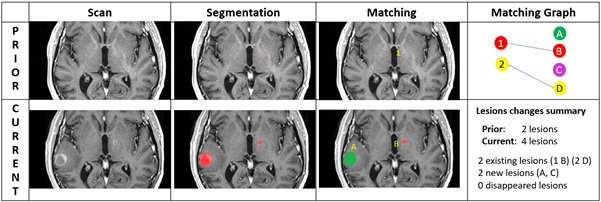After Stereotactic Radiosurgery treatment (SRS, a very precise form of therapeutic radiation) is performed on cancer patients with Metastatic Brain Tumors, close monitoring of the patients is essential for assessing the response to treatment and establishing the current brain health. The follow-up evaluation requires comparing MRI scans of the brain taken before and after treatment. Our team (at the CASMIP Lab and the Neurosurgery Department Hadassah University Medical Center) developed SimU-Net, a new deep learning computer model for the detection and quantitative comparative analysis of metastatic brain tumors in the MRI data. SimU-Net learns to detect changes based on the differences in the appearance between the brain metastases and the other brain structures. Our model was evaluated on 271 pairs of MRI scans and yielded expert-level accuracy for brain metastases whose size is greater than 5mm. SimU-Net may help doctors to track and assess treatment responses in patients with brain metastases after SRS.

Figure 1:
Illustration of the analysis of temporal changes of brain metastases of a patient before and after Stereotactic Radio Surgery: (a) representative registered slices of prior (top) and current (bottom) MRI scans; (b) annotation of two brain metastases (red) in the prior scan slice (top) and one in the current scan slice (bottom); one additional brain metastases in the prior scan and two in the current scans appear in different slices are not shown; (c) matching of the detected brain metastases in the prior scan (top, numbers) and in the current scan (bottom, letters) for the brain metastases appearing in the slices.


